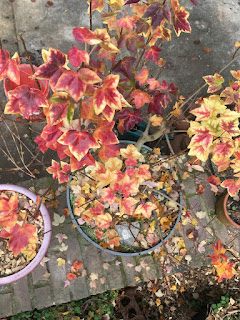Back in 2011, I purchased two Miyasama Yatsubusa aka Taiwanese Trident Maples
If you're an avid bonsai enthusiast, you probably already know that the Japanese have a long-standing love affair with the art of bonsai. They've been cultivating bonsai trees for centuries and have developed many different varieties that are sought after by bonsai enthusiasts all over the world. One of these coveted varieties is the Miyasama Yatsubusa Trident Maple.
Compared to the common Trident Maple available in the bonsai hobby, the Miyasama Yatsubusa Trident Maple is a rare and unique cultivar. It has a distinct look that sets it apart from other tridents. At a young age, the bark of this tree has a roughness that gives it a very interesting texture. This, combined with its small, delicate leaves and stunning autumn color, makes it an excellent choice for bonsai cultivation.
Although Miyasama Trident Maples have been a favorite of Japanese bonsai enthusiasts for many years, they're still relatively rare in the United States. However, if you're lucky, you may be able to find seedlings for sale on sites like eBay, as I have :) .
I actually won auction for two Miyasama Yatsubusa Trident Maple seedlings in 2011. They were only two years old when they arrived, but even at that young age, they had a distinctive look. I kept them in their nursery pots for a while, but eventually decided to plant one in the field and grow the other one in a bonsai pot.
Miyasama Trident Maples are slow growers. But with patience and care, they can thrive. Unfortunately, I lost one of their seedlings while attempting a root over rock project. It was pretty upsetting situation to be honest. I knew how rare they were and I feel the tree end up dying because of the extreme cold weather that season on a rack in that pot didn't give it any protection. Anyway, following the loss of that plant, and to ensure the survival of the remaining seedling, I moved it closer to the house and monitored carefully.
Over time, the Miyasama Yatsubusa Trident Maple grew nicely, and I was able to take an air layer off of it. I also managed to propagate a third plant from an air layer off of the second plant, resulting in three Miyasama trees in total: Grandma, Daughter, and Granddaughter. :)




 As time went by, I knew it was time to start thinking about moving it to a bonsai pot. I carefully prepared the potting mix and made sure the drainage holes were unobstructed. Then, with great care, I lifted the tree out of its training pot and placed it in its new home.
As time went by, I knew it was time to start thinking about moving it to a bonsai pot. I carefully prepared the potting mix and made sure the drainage holes were unobstructed. Then, with great care, I lifted the tree out of its training pot and placed it in its new home.







